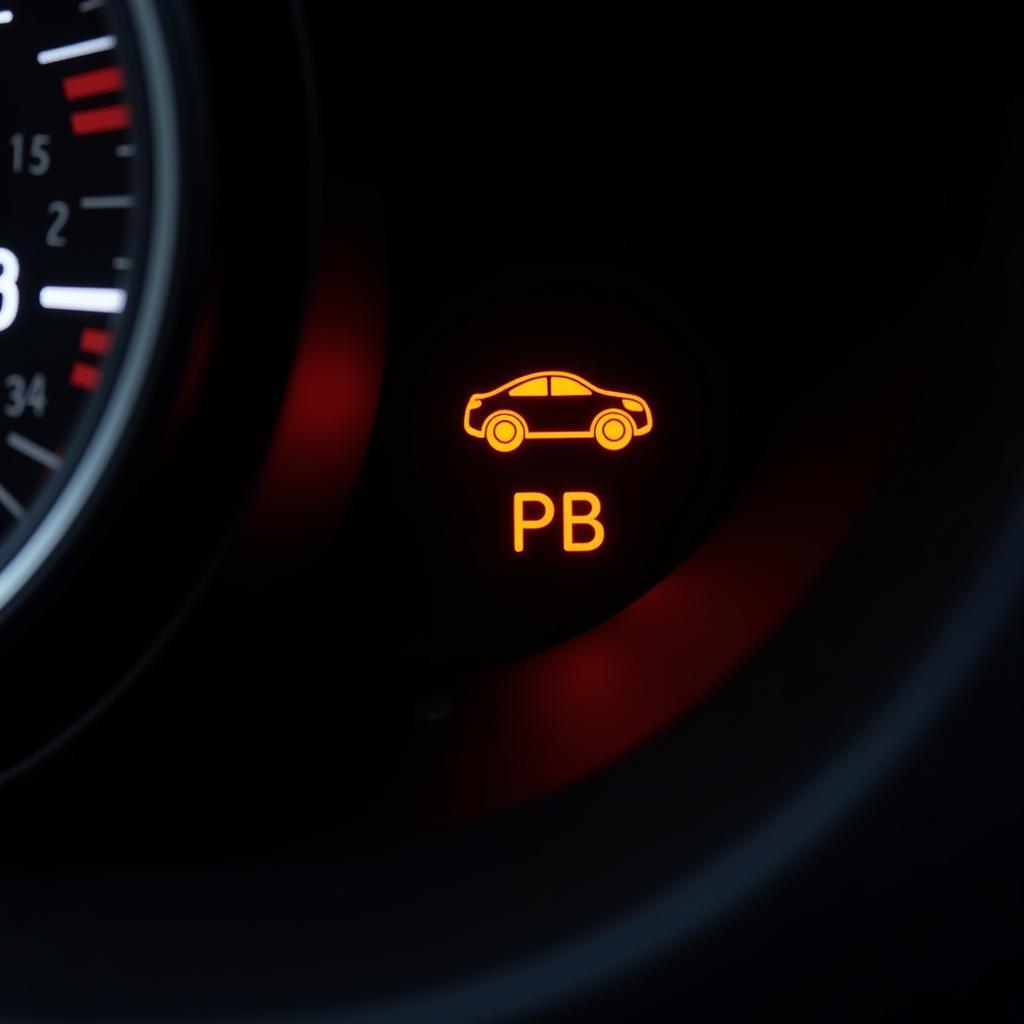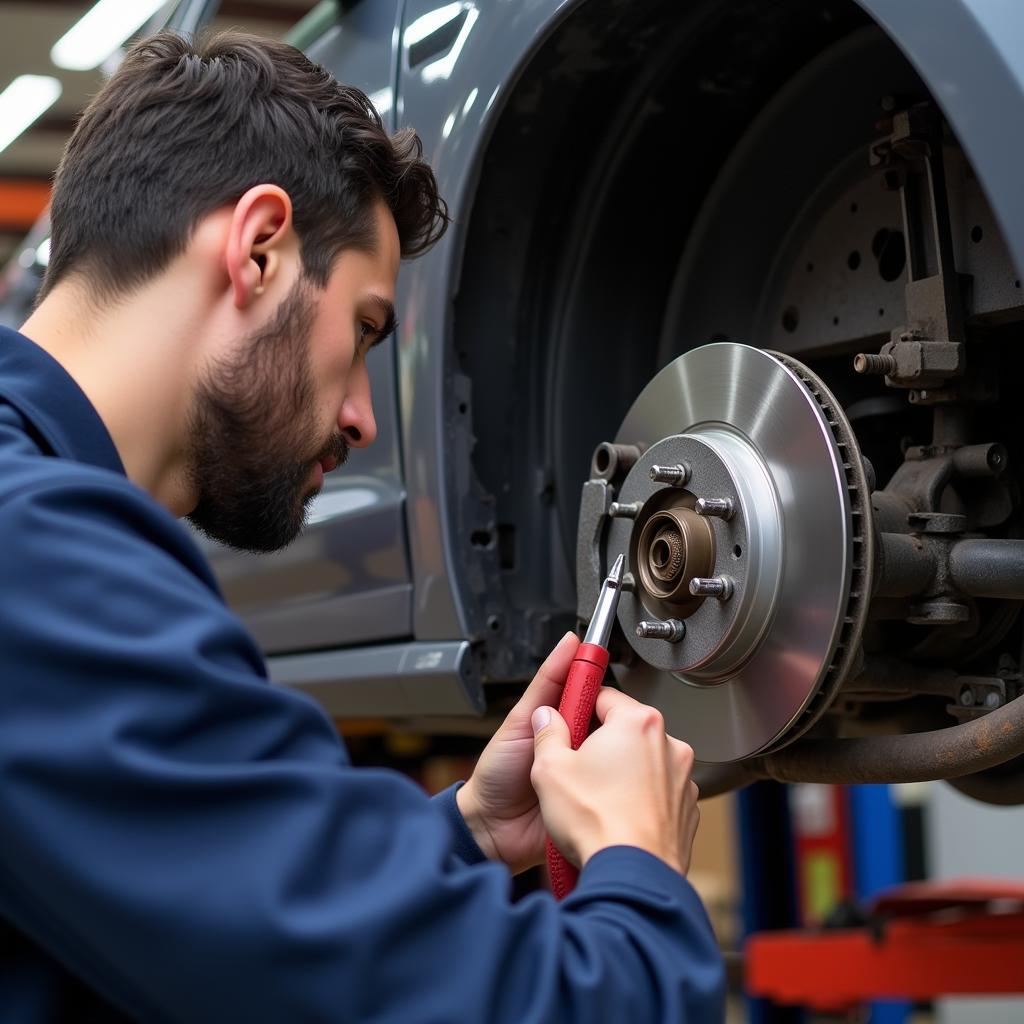The dreaded brake pad warning light illuminating on your dashboard can be a cause for concern, especially if an MOT is looming. Does it automatically mean an MOT failure? What does it signify and what steps should you take? This comprehensive guide will address these questions and explain everything you need to know about the brake pad warning light and its implications for your MOT.
Understanding Your Brake Pad Warning Light
The brake pad warning light, often depicted as a circle with parentheses on either side and an exclamation mark in the middle, serves as your car’s early warning system for brake pad wear. When illuminated, it indicates that your brake pads have worn down to a pre-determined point and require attention.
While the illumination of this light doesn’t necessarily mean your brakes are failing immediately, it should never be ignored. Ignoring this warning can lead to further damage, compromising your safety and potentially leading to a more expensive repair down the line.
 Brake Pad Warning Light on Dashboard
Brake Pad Warning Light on Dashboard
Brake Pad Warning Light and MOT: Will it Fail?
In short, yes, a glowing brake pad warning light will likely result in an MOT failure. The MOT test, a yearly requirement in the UK for vehicles over three years old, includes a thorough inspection of the braking system to ensure it meets safety standards.
A brake pad warning light signals potential issues with your braking system’s efficiency. This could be due to worn-out brake pads, issues with the brake fluid, or problems with the brake pad sensor itself. Regardless of the specific cause, it signifies a deviation from optimal braking performance, which is non-negotiable for passing an MOT.
Common Reasons Your Brake Pad Warning Light is On
There are several reasons why your brake pad warning light might be on:
-
Worn Brake Pads: The most common reason, and the one the system is designed to highlight, is that your brake pads have worn down to a point where they need replacing.
-
Faulty Brake Pad Sensor: Most modern vehicles have sensors within the brake pads that trigger the warning light when the pads reach a certain thickness. However, these sensors can malfunction, illuminating the light even when the brake pads are fine.
-
Low Brake Fluid: Brake fluid is essential for transferring the force you apply on the brake pedal to the wheels, ultimately stopping the vehicle. Low brake fluid can trigger the warning light, often indicating a leak in the system.
-
Electrical Issues: Like any electrical system, the brake warning light system can experience glitches. A short circuit or wiring issue could trigger the light without any underlying brake problem.
What to Do When Your Brake Pad Warning Light Comes On
If your brake pad warning light comes on, it’s crucial to:
-
Don’t Panic: While it’s a serious matter, it rarely requires immediate, emergency action. However, proceed with caution and avoid heavy braking or high speeds.
-
Assess Your Driving: If you’re experiencing any changes in braking performance, like a spongy brake pedal or unusual noises when braking, it’s even more critical to seek professional help immediately.
-
Schedule an Inspection: Whether experiencing other symptoms or not, book an inspection with a trusted mechanic or dealership as soon as possible to diagnose the issue.
Can a Mechanic Reset the Brake Pad Warning Light?
A qualified mechanic can use a diagnostic tool to reset the brake pad warning light. However, this should only be done after identifying and addressing the root cause of the light illuminating in the first place. Simply resetting the light without fixing the underlying issue offers a false sense of security and could have serious safety implications.
Tips for Prolonging Brake Pad Life
- Smooth Braking: Avoid harsh braking whenever possible. Gradual braking reduces wear and tear on your brake pads.
- Lighten Your Load: Excess weight in your vehicle forces your brakes to work harder, leading to faster wear on the brake pads.
- Maintain Proper Tire Pressure: Underinflated tires create more rolling resistance, making your engine and brakes work harder.
 Mechanic Inspecting Car Brakes
Mechanic Inspecting Car Brakes
Brake Pad Warning Light MOT: The Takeaway
Ignoring a brake pad warning light is a gamble you should never take. While the reasons for its illumination might range from simple wear and tear to more complex electrical issues, it always warrants immediate attention. Addressing the problem promptly not only ensures you pass your MOT but, more importantly, guarantees your safety and the safety of others on the road. Remember, maintaining your vehicle’s braking system is not just a legal requirement; it’s a responsibility you owe to yourself and everyone else on the road.
